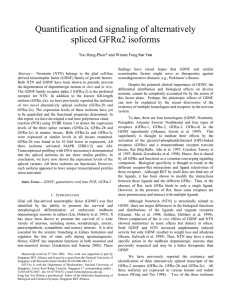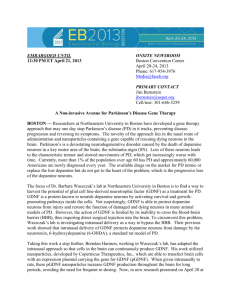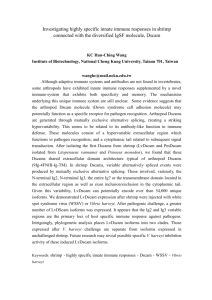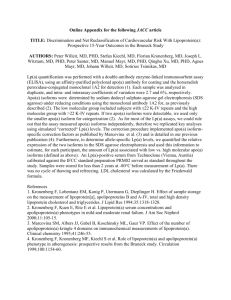Study of GDNF-Family Receptor Alpha 2 And 2b (GFRα2b) isoform
advertisement
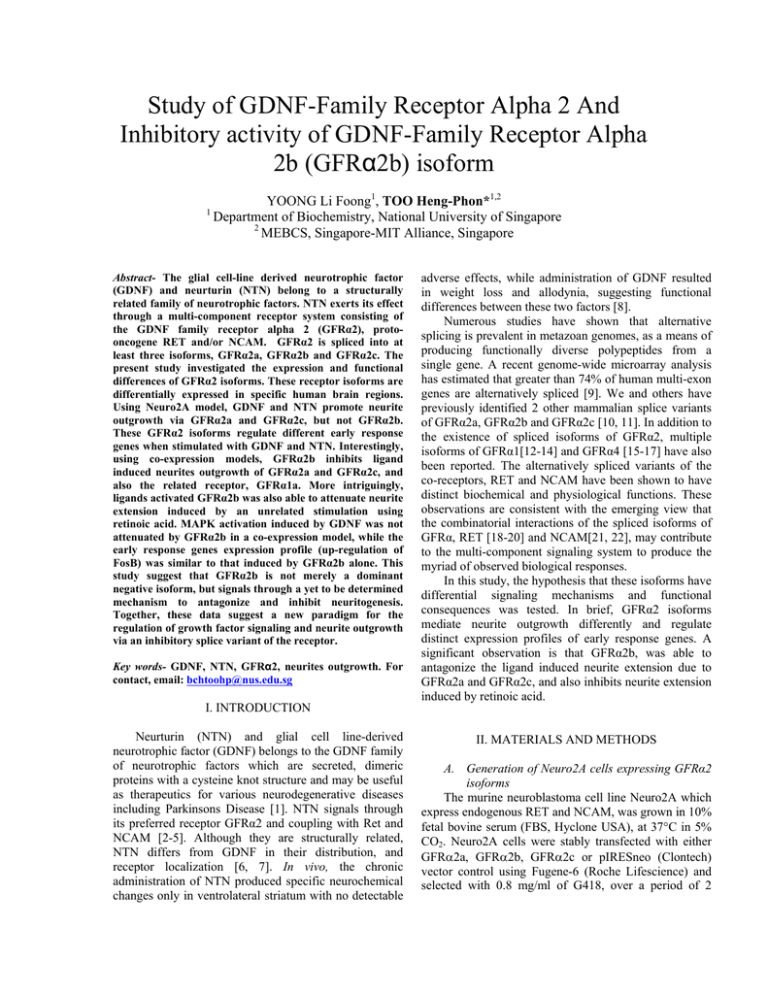
Study of GDNF-Family Receptor Alpha 2 And Inhibitory activity of GDNF-Family Receptor Alpha 2b (GFRα2b) isoform 1 YOONG Li Foong1, TOO Heng-Phon*1,2 Department of Biochemistry, National University of Singapore 2 MEBCS, Singapore-MIT Alliance, Singapore Abstract- The glial cell-line derived neurotrophic factor (GDNF) and neurturin (NTN) belong to a structurally related family of neurotrophic factors. NTN exerts its effect through a multi-component receptor system consisting of the GDNF family receptor alpha 2 (GFRα2), protooncogene RET and/or NCAM. GFRα2 is spliced into at least three isoforms, GFRα2a, GFRα2b and GFRα2c. The present study investigated the expression and functional differences of GFRα2 isoforms. These receptor isoforms are differentially expressed in specific human brain regions. Using Neuro2A model, GDNF and NTN promote neurite outgrowth via GFRα2a and GFRα2c, but not GFRα2b. These GFRα2 isoforms regulate different early response genes when stimulated with GDNF and NTN. Interestingly, using co-expression models, GFRα2b inhibits ligand induced neurites outgrowth of GFRα2a and GFRα2c, and also the related receptor, GFRα1a. More intriguingly, ligands activated GFRα2b was also able to attenuate neurite extension induced by an unrelated stimulation using retinoic acid. MAPK activation induced by GDNF was not attenuated by GFRα2b in a co-expression model, while the early response genes expression profile (up-regulation of FosB) was similar to that induced by GFRα2b alone. This study suggest that GFRα2b is not merely a dominant negative isoform, but signals through a yet to be determined mechanism to antagonize and inhibit neuritogenesis. Together, these data suggest a new paradigm for the regulation of growth factor signaling and neurite outgrowth via an inhibitory splice variant of the receptor. Key words- GDNF, NTN, GFRα2, neurites outgrowth. For contact, email: bchtoohp@nus.edu.sg I. INTRODUCTION Neurturin (NTN) and glial cell line-derived neurotrophic factor (GDNF) belongs to the GDNF family of neurotrophic factors which are secreted, dimeric proteins with a cysteine knot structure and may be useful as therapeutics for various neurodegenerative diseases including Parkinsons Disease [1]. NTN signals through its preferred receptor GFRα2 and coupling with Ret and NCAM [2-5]. Although they are structurally related, NTN differs from GDNF in their distribution, and receptor localization [6, 7]. In vivo, the chronic administration of NTN produced specific neurochemical changes only in ventrolateral striatum with no detectable adverse effects, while administration of GDNF resulted in weight loss and allodynia, suggesting functional differences between these two factors [8]. Numerous studies have shown that alternative splicing is prevalent in metazoan genomes, as a means of producing functionally diverse polypeptides from a single gene. A recent genome-wide microarray analysis has estimated that greater than 74% of human multi-exon genes are alternatively spliced [9]. We and others have previously identified 2 other mammalian splice variants of GFRα2a, GFRα2b and GFRα2c [10, 11]. In addition to the existence of spliced isoforms of GFRα2, multiple isoforms of GFRα1[12-14] and GFRα4 [15-17] have also been reported. The alternatively spliced variants of the co-receptors, RET and NCAM have been shown to have distinct biochemical and physiological functions. These observations are consistent with the emerging view that the combinatorial interactions of the spliced isoforms of GFRα, RET [18-20] and NCAM[21, 22], may contribute to the multi-component signaling system to produce the myriad of observed biological responses. In this study, the hypothesis that these isoforms have differential signaling mechanisms and functional consequences was tested. In brief, GFRα2 isoforms mediate neurite outgrowth differently and regulate distinct expression profiles of early response genes. A significant observation is that GFRα2b, was able to antagonize the ligand induced neurite extension due to GFRα2a and GFRα2c, and also inhibits neurite extension induced by retinoic acid. II. MATERIALS AND METHODS A. Generation of Neuro2A cells expressing GFRα2 isoforms The murine neuroblastoma cell line Neuro2A which express endogenous RET and NCAM, was grown in 10% fetal bovine serum (FBS, Hyclone USA), at 37°C in 5% CO2. Neuro2A cells were stably transfected with either GFRα2a, GFRα2b, GFRα2c or pIRESneo (Clontech) vector control using Fugene-6 (Roche Lifescience) and selected with 0.8 mg/ml of G418, over a period of 2 months. Primers used for measuring GFRα2 isoforms expression were as previously described [23]. All subsequence studies were repeated with 3 individual clones. Fig.1 Ligand- induced differentiation of Neuro2a stably expressing GFRα2 isoforms. Cells treated with retinoic acid (RA), GDNF or NTN (50 ng/ ml) for 3 days. Percentage of cells bearing neurites which were twice the length of the cells body was scored. Similar results were repeated with 3 separate clones. Statistical significance was calculated between ligand stimulated and control conditions using paired Students t-test. A value of P<0.05 was considered significant (*P<0.002). B. Assessment of differentiation in GFRα2 cells induced by GDNF or NTN Twenty thousand cells per well were seeded on 6 wells plate over night, at 10% serum DMEM. Cells were then incubated with 0.5% serum media, with or without GDNF or NTN (50 ng/ ml). Cells were then incubated for further 3 days. Retinoic Acid (5µM) was used as a positive control for inducing differentiation. Percentages of differentiation were counted for cells bearing neurites twice the length of the cells body. More than 600 cells from three random areas were counted per well. Significant differences in percentage of differences between ligand stimulated and control were calculated using paired Students t-test. A value of P<0.05 was considered significant. C. Analysis of MAP Kinase (Erk1/2) phosphorylation Phosphorylation of Erk1/Erk2 (Erk1/2) was analyzed as follows. Cells were seeded in DMEM with 10% FBS for 24 h, followed by serum depletion (0.5% FBS) for 16 h. The cells were then treated with 50 ng/ml of GDNF, NTN, Artemin or Persephin (PreproTech, England) in serum free media for different time course at 37 °C. For dose response studies, cells were stimulated with different concentration of ligands for 10 min in 37 °C. Control treatment with 1 M Sorbitol (Sigma) was carried out simultaneously. The supernatants were removed and cells were washed once with phosphatebuffered saline (PBS) and subsequently lysed in 2% SDS. Protein concentrations were determined using BCA (Pierce, Rockland USA). Western blot using phospho- specific antibodies according to the manufacturer’s instructions (Cell Signaling Technologies). Blots were stripped and reprobed with actin (Dako) antibodies to verify equal loading of protein. D. Measurements of early response genes regulated by GDNF and NTN Cells were seeded in DMEM with 10% FBS for 24 h, followed by serum depletion (0.5% FBS) for 16 h. The cells were then treated with 50 ng/ml of GDNF and NTN (PreproTech, England) in serum free media for different time course at 37 °C. To terminate, total RNA isolation and reverse transcription were performed as described above. Quantitative real time PCR were performed as mentioned above, using specifically designed primers, in parallel with plasmid as standard. The fold changes in the target gene, normalized to GAPDH and relative to the expression in control sample. III. RESULTS A. GFRα2 isoforms induced different morphological changes Neuro2A is a mouse neuroblastoma that does not express GFRα1 or GFRα2, but express Ret and NCAM, the co-receptors of GFRαs (data not shown). Hence, we have stably transfected Neuro2A with GFRα2a, GFRα2b, or GFRα2c to generate a cell model to study the functions of GFRα2 isoforms. GDNF and NTN (50 ng/ ml) were able to induce neurites outgrowth in Neuro2A cells via GFRα2a and GFRα2c, but not in GFRα2b (Fig.1). Retinoic acid served as a positive control for neurite outgrowth in all the three GFRα2 isoforms transfected cells. The percentage of cells bearing neurites in ligand-induced GFRα2a and GFRα2c were comparable to those induced by retinoic acid. Fig.2 Ligand induced activation of ERK1/2 in Neuro2a cells stably expressing GFRα2 isoforms. Cells were treated with ligand with designated time points, phosphorylation of ERK1/2 were detected by Western blot analysis. Equal loading were controlled by reprobe for actin. B. GDNF and NTN showed some selectivity in MAPK activation on GFRα2 isoforms NTN phosphorylated ERK1/2 equally well in all three GFRα2 isoform transfected cells (Fig.2). However, GDNF was only able to induce ERK1/2 activation in GFRα2a and GFRα2c, but not GFRα2b. At supramaximal dose of GDNF (200 ng/ml), ERK1/2 was activated only in GFRα2a and GFRα2c transfected cells (data not shown). Interestingly, radioactive labeled GDNF binding studies showed that all GFRα2 isoforms bound GDNF with similar affinities (data not shown). B. Fig. 3 Studies of neuritogenesis inhibition of GFRα2b. (A.) Using co-expression model, GFRα2b antagonizes ligand induced neurites outgrowth of GFRα2a and GFRα2c. (B.) Ligand activated GFRα2b were able to attenuates neurites outgrowth induced by retinoic acid (RA) (5 µM). C. GFRα2 isoforms regulates distinct early response genes To further understand the mechanisms underlying the activation of GFRα2 isoforms, we investigated the regulation of some early response genes or transcription factors in ligand activated GFRα2 isoforms. The changes in expression of genes from fos family (c-fos, fos-B), jun family (c-jun, jun-b), egr family (egr1-4), Zinc finger protein 393 (Zfp393), and GDNF inducible transcription factors mGIF and mGZF1 in GDNF and NTN treated GFRα2 isoforms were studied. As summarized in Table 1, GFRα2 isoforms regulated different sets of early response genes. The expressions of these genes were upregulated and peaked (5 to 10 fold increment) at 1 hour post ligand treatment, and gradually declined for the next 6 hours. A. D. GFRα2b antagonizes neurites outgrowth of retinoic acid and ligand activated GFRα2a and GFRα2c To understand the potential combinatorial functions of GFRα2 isoforms, we examined the effects of GFRα2b on neurite extension due to the other GFRα2 isoforms in a co-expression model. GFRα2b was cloned into the downstream EMCV IRES driven multiple cloning, while GFRα2a or GFRα2c were cloned into the upstream multiple cloning driven by a CMV promoter. Intriguingly, GFRα2b inhibited the neurite extensions induced by GFRα2a and GFRα2c (Fig.3a). Retinoic acid induced differentiation in all the cell lines, verifying that transfection did not affect the abilities of these cells to differentiate. Next, the possibility that GFRα2b may attenuate neurites outgrowth induced by non-GFRα stimuli was investigated. Using the co-expression cell model, GDNF and NTN activated GFRα2b and resulted in the inhibition of neurite outgrowth induced by retinoic acids (Fig. 3b). We further investigated the effects of GFRα2b on signaling and the regulation of early response gene expressions induced by GFRα2a/ 2c. Ligand induced MAPK (ERK1/2) activations were not affected in the coexpression model (Fig. 4). However, profiles of ligand induced early response genes regulation were that induced by GFRα2b activation (fosB was up-regulated) (Table 2). inhibiting the differentiation induced by other growth factors such as NGF and BDNF will be studied. V. CONCLUSION GFRα2 isoforms have significant functions, and activation mechanisms. We have shown that GFRα2b is an inhibitory isoform, which antagonizes GFRα2a and GFRα2c. Furthermore, ligand activated GFRα2b was able to attenuate retinoic acid induced neuritogenesis. Together, these data suggest a new paradigm for the regulation of growth factor signaling and neurite outgrowth via an inhibitory splice variant of the receptor. Fig. 4 Study of ERK1/2 activation in GFRα2 isoforms co-expression model. Neuro2A cells stably co-expressing GFRα2 isoforms were treated with ligand for 10 min. ERK1/2 phosphorylation was analyzed by Western blot. Equal loading of protein were confirmed with reprobe for Actin. REFERENCES [1] IV. DISCUSSION Alternative RNA splicing is a commonly used strategy for creating a functionally diverse pool of gene products derived from a single gene. The emerging view is that the truncated spliced isoforms may act as a inhibitor or regulator for the activity full-length isoforms. During our investigations on the functions of GFRα2 isoforms, we made several observations that led to unexpected insights into the inhibitory activity of GFRα2b on its isoforms counterparts. We have previously shown that GFRα2 isoforms are differently expressed in murine brain and peripheral tissues[23]. These suggested that all three GFRα2 isoforms may have significant and distinct physiological role in vivo. In this study, we have shown that GFRα2 isoforms have different activation mechanism and distinct functional consequences. More importantly, we have shown that GFRα2b antagonizes GFRα2a and GFRα2b. Dominant negative activity of receptor splice variants have been recently shown in other systems, such as Glucocorticoid receptor [24], Gonadotropin releasing hormone receptor [25] and PPAR receptor [26]. However, unlike these dominant negative isoforms, we have now shown that MAPK activations and fosB up-regulations in GFRα2b isoform and that this isoform was also able to attenuate differentiation induced by non- GFRα2 stimuli like retinoic acid. These indicate that GFRα2b is not merely a dominant negative isoform, but more likely to activate events that have extensive inhibitory activities. GFRα2 might be utilizing a yet to be identified mechanism in its antagonism and neuritogenesis inhibition. The mechanism and signaling pathway(s) involved in GFRα2b inhibitory activity is currently being investigated. In addition, the potential of GFRα2b in [2] [3] [4] [5] [6] [7] [8] [9] [10] [11] [12] P. T. Kotzbauer, P. A. Lampe, R. O. Heuckeroth, J. P. Golden, D. J. Creedon, E. M. Johnson, Jr., and J. Milbrandt, "Neurturin, a relative of glial-cell-line-derived neurotrophic factor," Nature, vol. 384, pp. 467-70, 1996. J. Widenfalk, C. Nosrat, A. Tomac, H. Westphal, B. Hoffer, and L. Olson, "Neurturin and glial cell line-derived neurotrophic factor receptor-beta (GDNFR-beta), novel proteins related to GDNF and GDNFR-alpha with specific cellular patterns of expression suggesting roles in the developing and adult nervous system and in peripheral organs," J Neurosci, vol. 17, pp. 8506-19, 1997. R. H. Baloh, M. G. Tansey, J. P. Golden, D. J. Creedon, R. O. Heuckeroth, C. L. Keck, D. B. Zimonjic, N. C. Popescu, E. M. Johnson, Jr., and J. Milbrandt, "TrnR2, a novel receptor that mediates neurturin and GDNF signaling through Ret," Neuron, vol. 18, pp. 793-802, 1997. A. Buj-Bello, J. Adu, L. G. Pinon, A. Horton, J. Thompson, A. Rosenthal, M. Chinchetru, V. L. Buchman, and A. M. Davies, "Neurturin responsiveness requires a GPI-linked receptor and the Ret receptor tyrosine kinase," Nature, vol. 387, pp. 721-4, 1997. G. Paratcha, F. Ledda, and C. F. Ibanez, "The neural cell adhesion molecule NCAM is an alternative signaling receptor for GDNF family ligands," Cell, vol. 113, pp. 86779, 2003. J. P. Golden, J. A. DeMaro, P. A. Osborne, J. Milbrandt, and E. M. Johnson, Jr., "Expression of neurturin, GDNF, and GDNF family-receptor mRNA in the developing and mature mouse," Exp Neurol, vol. 158, pp. 504-28, 1999. J. Widenfalk, M. Parvinen, E. Lindqvist, and L. Olson, "Neurturin, RET, GFRalpha-1 and GFRalpha-2, but not GFRalpha-3, mRNA are expressed in mice gonads," Cell Tissue Res, vol. 299, pp. 409-15, 2000. M. R. Hoane, A. G. Gulwadi, S. Morrison, G. Hovanesian, M. D. Lindner, and W. Tao, "Differential in vivo effects of neurturin and glial cell-line-derived neurotrophic factor," Exp Neurol, vol. 160, pp. 235-43, 1999. B. Modrek and C. Lee, "A genomic view of alternative splicing," Nat Genet, vol. 30, pp. 13-9, 2002. Y. W. Wong and H. P. Too, "Identification of mammalian GFRalpha-2 splice isoforms," Neuroreport, vol. 9, pp. 376773, 1998. N. F. Dolatshad, A. T. Silva, and M. J. Saffrey, "Identification of GFR alpha-2 isoforms in myenteric plexus of postnatal and adult rat intestine," Brain Res Mol Brain Res, vol. 107, pp. 32-8, 2002. B. K. Dey, Y. W. Wong, and H. P. Too, "Cloning of a novel murine isoform of the glial cell line-derived neurotrophic factor receptor," Neuroreport, vol. 9, pp. 37-42, 1998. [13] [14] [15] [16] [17] [18] M. Sanicola, C. Hession, D. Worley, P. Carmillo, C. Ehrenfels, L. Walus, S. Robinson, G. Jaworski, H. Wei, R. Tizard, A. Whitty, R. B. Pepinsky, and R. L. Cate, "Glial cell line-derived neurotrophic factor-dependent RET activation can be mediated by two different cell-surface accessory proteins," Proc Natl Acad Sci U S A, vol. 94, pp. 6238-43, 1997. S. E. Shefelbine, S. Khorana, P. N. Schultz, E. Huang, N. Thobe, Z. J. Hu, G. M. Fox, S. Jing, G. J. Cote, and R. F. Gagel, "Mutational analysis of the GDNF/RET-GDNFR alpha signaling complex in a kindred with vesicoureteral reflux," Hum Genet, vol. 102, pp. 474-8, 1998. M. Lindahl, T. Timmusk, J. Rossi, M. Saarma, and M. S. Airaksinen, "Expression and alternative splicing of mouse Gfra4 suggest roles in endocrine cell development," Mol Cell Neurosci, vol. 15, pp. 522-33, 2000. M. Lindahl, D. Poteryaev, L. Yu, U. Arumae, T. Timmusk, I. Bongarzone, A. Aiello, M. A. Pierotti, M. S. Airaksinen, and M. Saarma, "Human glial cell line-derived neurotrophic factor receptor alpha 4 is the receptor for persephin and is predominantly expressed in normal and malignant thyroid medullary cells," J Biol Chem, vol. 276, pp. 9344-51, 2001. S. Masure, M. Cik, E. Hoefnagel, C. A. Nosrat, I. Van der Linden, R. Scott, P. Van Gompel, A. S. Lesage, P. Verhasselt, C. F. Ibanez, and R. D. Gordon, "Mammalian GFRalpha -4, a divergent member of the GFRalpha family of coreceptors for glial cell line-derived neurotrophic factor family ligands, is a receptor for the neurotrophic factor persephin," J Biol Chem, vol. 275, pp. 39427-34, 2000. E. de Graaff, S. Srinivas, C. Kilkenny, V. D'Agati, B. S. Mankoo, F. Costantini, and V. Pachnis, "Differential activities of the RET tyrosine kinase receptor isoforms during mammalian embryogenesis," Genes Dev, vol. 15, pp. 2433-44, 2001. [19] [20] [21] [22] [23] [24] [25] [26] D. C. Lee, K. W. Chan, and S. Y. Chan, "RET receptor tyrosine kinase isoforms in kidney function and disease," Oncogene, vol. 21, pp. 5582-92, 2002. M. J. Lorenzo, G. D. Gish, C. Houghton, T. J. Stonehouse, T. Pawson, B. A. Ponder, and D. P. Smith, "RET alternate splicing influences the interaction of activated RET with the SH2 and PTB domains of Shc, and the SH2 domain of Grb2," Oncogene, vol. 14, pp. 763-71, 1997. B. Buttner, W. Reutter, and R. Horstkorte, "Cytoplasmic domain of NCAM 180 reduces NCAM-mediated neurite outgrowth," J Neurosci Res, vol. 75, pp. 854-60, 2004. G. K. Povlsen, D. K. Ditlevsen, V. Berezin, and E. Bock, "Intracellular signaling by the neural cell adhesion molecule," Neurochem Res, vol. 28, pp. 127-41, 2003. H. P. Too, "Real time PCR quantification of GFRalpha-2 alternatively spliced isoforms in murine brain and peripheral tissues," Brain Res Mol Brain Res, vol. 114, pp. 146-53, 2003. R. H. Oakley, C. M. Jewell, M. R. Yudt, D. M. Bofetiado, and J. A. Cidlowski, "The dominant negative activity of the human glucocorticoid receptor beta isoform. Specificity and mechanisms of action," J Biol Chem, vol. 274, pp. 27857-66, 1999. L. Wang, D. Y. Oh, J. Bogerd, H. S. Choi, R. S. Ahn, J. Y. Seong, and H. B. Kwon, "Inhibitory activity of alternative splice variants of the bullfrog GnRH receptor-3 on wild-type receptor signaling," Endocrinology, vol. 142, pp. 4015-25, 2001. P. Gervois, I. P. Torra, G. Chinetti, T. Grotzinger, G. Dubois, J. C. Fruchart, J. Fruchart-Najib, E. Leitersdorf, and B. Staels, "A truncated human peroxisome proliferatoractivated receptor alpha splice variant with dominant negative activity," Mol Endocrinol, vol. 13, pp. 1535-49, 1999.
